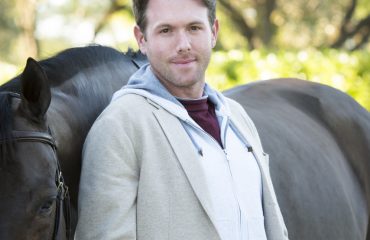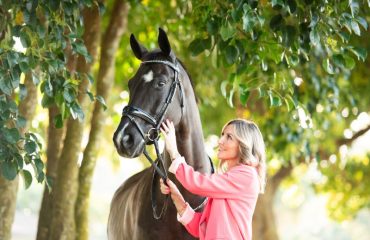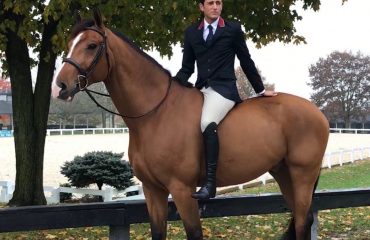By Dani Moritz
How do you describe therapeutic riding — what it is, what it does? You could describe it as sensory stimulation that inspires physical and emotional improvements among the mentally and physically disabled. You could say it mimics walking, instills confidence, is a platform for learning — all of which are true, but none of which truly captures precisely what therapeutic riding really is.
Perhaps the best way to describe it is making miracles.
In reality, therapeutic riding is the feeling a mother gets when she hears her 7-year-old daughter laugh for the very first time at the simple sight of a horse sneezing. It’s the tears that rush down a parent’s cheek as her child speaks his first word to the trusty steed beneath him. It’s the smile that overcomes a father’s face when his little boy holds himself up for the very first time and proves to the world that he has what it takes. You could even describe it as a little girl who once struggled through every day, knowing and accepting that it might be her last, but now has something to live for — because each week she battles on in another day atop her favorite horse.
Every day across the country, thousands of volunteers, instructors and, perhaps most importantly, horses, change the lives of people who otherwise have little to look forward to. They give people their first words, their first smile, a way to communicate and the freedom of movement to those otherwise confined to a wheelchair.
At SIRE, in the Houston, Texas area, they’ve been inspiring these miracles since 1974 — each of the aforementioned miracles included.
It Takes a Village
In 2013 alone, SIRE served 307 clients with 77 different diagnoses with a 98 percent improvement rate. To serve these clients, it takes four PATH Master-certified instructors, 15 additional certified instructors, nine support staff, 27 therapy horses and 550 volunteers.
These numbers include all three of their Houston-area facilities — in Hockley, Spring and Fort Bend — making SIRE one of the largest premier PATH-accredited riding centers in the country. SIRE also happens to be a major training hub for PATH-certified instructors and soon-to-be instructors. At the moment, one gentleman from Korea is studying at SIRE. Tomorrow, one of SIRE’s four master instructors may very well be jet setting off to Japan or Israel to help train others.
With all the excitement, Anthony Busacca, Hockley site director and PATH master-certified instructor, says they couldn’t do it without their volunteers, who contributed more than $700,000 worth of working hours in 2013. “Without the community and their time, we just couldn’t do it,” he said.
Of course, the horses are also instrumental. “I can’t say enough about horses as therapy animals,” said Shayna Bolton, Spring site director. “They’re amazing in so many ways. A horse is nonjudgmental and very forgiving. Their walk is similar to a human gait. Horse riding at a walking gait can generate motor and sensory inputs similar to those produced by human walking and, because of this, it can be very beneficial as a therapy for someone with ambulatory challenges.”
Utilizing their two-legged and four-legged staff, the centers treat clients with a variety of physical and mental disabilities — including, but not limited to, those with autism, cerebral palsy, spinal cord injuries and post-traumatic stress disorder (PTSD).
Clients range from children to adults, and even veterans of the Armed Forces. “We have quite a variety of riders — everywhere from 3-year-old children to 80-year-old adults with Alzheimer’s, people with severe physical handicaps and people on the autism spectrum with social problems and behavioral issues,” Anthony said.

SIRE volunteer Karen Hawkins leads Alexys Manske at the CGG Saddle Up for SIRE Ride-a-thon at the 7iL Ranch in Cat Spring, Texas.
Photo courtesy of SIRE.
Overcoming Challenges
While every day is a blessing at SIRE, it’s also a major undertaking. With so many different types of riders with varying needs, volunteers and staff need to be well educated and prepared to handle difficult situations.
Anthony explains that for people on the autism spectrum, communication is a primary challenge. “For people with autism who have more social, behavioral or cognitive issues, there are challenges in making that connection. They tend to live in a parallel world. They don’t like social interaction. They’re withdrawn. So with the horse being a less threatening creature, it’s easier for them to start making connections with the horse by bonding.”
However, that doesn’t mean making the connection with the horse is easy either. He explained that sometimes students are fearful of the horse and will be placed on the horse while kicking and screaming, at the request of their parents. After a lap or two around the ring, Anthony says that with most clients something clicks and the next time they come to ride they’re eager to get back into the saddle.
With physically disabled clients, Anthony says it’s all about balance and alignment. Often times, clients spend their entire lives in a wheelchair and riding is a unique opportunity for them to feel motion through the footfalls of a horse. This, of course, is an extremely positive undertaking for them, but a major undertaking nonetheless. While riding, these clients use muscle groups they haven’t used before and struggle to achieve balance. However, after spending time on the back of a horse, disabled clients build strength, stamina and balance.
For military veterans, Shayna, who’s also head of the military program, says the greatest challenge is encouraging participation. “It’s been challenging to find individuals who want to participate, but once we get them on-site with the horses most of them are hooked!”
She noted an additional challenge is a horse’s innate ability to sense and mirror emotions. Veterans with emotional issues such as PTSD who react negatively to situations will have to overcome working with a horse that mirrors those negative emotions. Ultimately, however, overcoming that challenge builds confidence.

Ainsley Alley on Max prepares for jousting at the All SIRE Horse Show in May 2014. SIRE board member Reneé Adair is leading Max.
Photo by Jaana Eleftheriou
Celebrating Small Victories
Fortunately at SIRE, and therapeutic riding programs around the globe, most (if not all) challenges come with victories. Whether small or grand, each victory is a major accomplishment for these riders.
Shayna explains the power of experiencing and witnessing these victories. “I see first-hand how much our riders work and grow physically, cognitively and emotionally like learning how to walk or gaining the ability to go up and down stairs, but sometimes it’s the small accomplishments that are so special,” she said. “I had one mother almost in tears because her son was able to pick up Cheetos and eat them. We were all laughing that it was funny how happy she was that her son was eating junk food. It was the first time his parents saw him pick up food and eat it.”
Another victory that may seem small to the able-bodied but incredible to the physically disabled is the ability to look down and the freedom that comes with it. “When you think about it, when someone uses a wheelchair they are always sitting down looking up at everyone else,” Anthony explained. “But they get on a horse, and now they’re looking down. It’s those subtle psychological things that make people feel equal instead of like a second class citizen.”
He says that therapeutic riding can also encourage major victories for clients with learning disabilities who are often outcast for learning differently and labeled unintelligent. “When they get to ride, all of a sudden they’re better at something, they’re special and it has equalized them in society,” he explained.
While Anthony admits sometimes breakthroughs come in such little increments it feels like watching grass grow, to Anthony, Shayna and all of the volunteers and staff at SIRE every second is worth it. And as much as they put into SIRE, SIRE gives back so much to them.
“SIRE has had an amazing impact on my life,” Shayna said. “I get to witness miracles every day. I see our clients work so hard as they face huge challenges. It makes me so thankful for what I have and that I can help facilitate bringing joy to lives through horses.”















